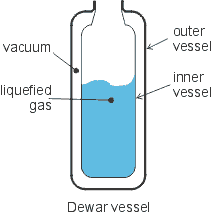Dewar Vessel
 Dewar
vessel is used for storing liquids (liquefied gases) at low temperatures.
It is a vessel with double walls, the space between which is evacuated.
The vessel was devised to preserve liquefied gases by preventing the transfer
of heat from the surroundings to the liquid. The evacuated space between
the walls (which are ordinarily glass or steel) is practically a nonconductor
of heat. The radiation is reduced to a minimum by silvering the glass or
steel. The chief path by which heat can be communicated to the interior
of the inner vessel is at the vessel's neck, the only junction of the walls,
which therefore is made as small as possible. This thermal isolation applies
equally to heat, a hot liquid remaining at a high temperature in the flask
for several hours.
Dewar
vessel is used for storing liquids (liquefied gases) at low temperatures.
It is a vessel with double walls, the space between which is evacuated.
The vessel was devised to preserve liquefied gases by preventing the transfer
of heat from the surroundings to the liquid. The evacuated space between
the walls (which are ordinarily glass or steel) is practically a nonconductor
of heat. The radiation is reduced to a minimum by silvering the glass or
steel. The chief path by which heat can be communicated to the interior
of the inner vessel is at the vessel's neck, the only junction of the walls,
which therefore is made as small as possible. This thermal isolation applies
equally to heat, a hot liquid remaining at a high temperature in the flask
for several hours.It is named after the inventor Sir James Dewar (1842-1923). He was British chemist and physicist and invented double walled vacuum flask in the 1890s.
Today Dewar vessel is widely used in low temperature science and applications. It is also well known as a thermos flask for conserving hot liquids (tea, coffee).
Last revised: Dec.19. 2000, © Andrej